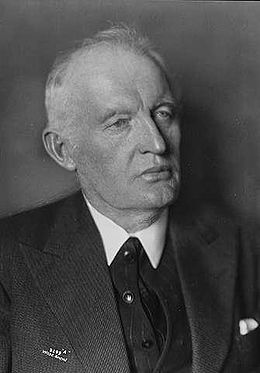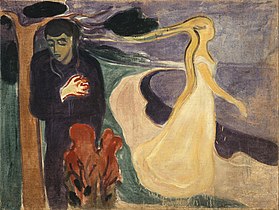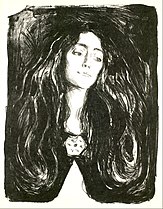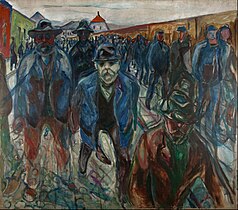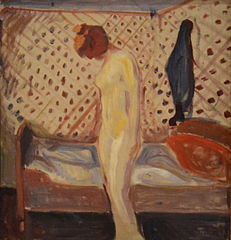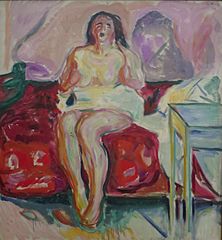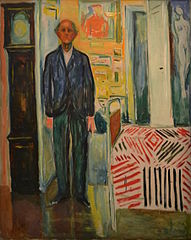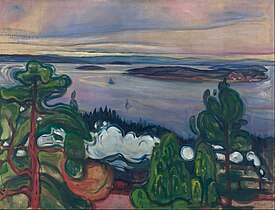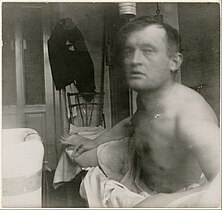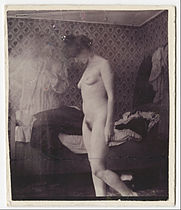Edvard Munch
Yi palo
Edvard Munch (/mʊŋk/ MUUNK;[1] Norwegian: [ˈɛ̀dvɑɖ ˈmʊŋk] (![]() listen); 12 December 1863 – 23 January 1944) o daa nyɛla Norway peenta-peenta. O yuuni 1893 tuuni The Scream nyɛla di leei "Western art's" anfooni shɛli niriba ni taɣi deei pam.[2]
listen); 12 December 1863 – 23 January 1944) o daa nyɛla Norway peenta-peenta. O yuuni 1893 tuuni The Scream nyɛla di leei "Western art's" anfooni shɛli niriba ni taɣi deei pam.[2]

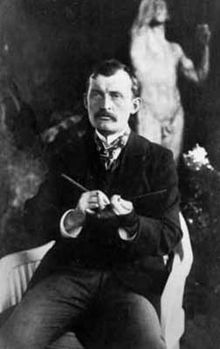






From my rotting body,
flowers shall grow
and I am in them
and that is eternity.
Edvard Munch[6]
Tuun-zuɣuri
[mali niŋ | mali mi di yibu sheena n-niŋ]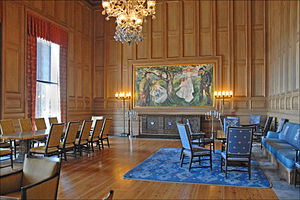
- 1885–1886: The Sick Child
- 1892: Evening on Karl Johan
- 1893: The Scream
- 1894: Ashes
- 1894: Despair
- 1894: Woman in Three Stages
- 1894–1895: Madonna
- 1894–1896: Melancholy
- 1895: Puberty
- 1895: Self-Portrait with Cigarette
- 1895: Death in the Sickroom
- 1899–1900: The Dance of Life
- 1899–1900: The Dead Mother
- 1903: Village in Moonlight
- 1940–1942: Self-Portrait. Between the Clock and the Bed.
Tuun'shɛŋa
[mali niŋ | mali mi di yibu sheena n-niŋ]- The Dance of Life, 1899–1900, oil on canvas, 126 cm × 191 cm (49+1⁄2 in × 75 in), Nasjonalgalleriet, Oslo
- At the Roulette Table in Monte Carlo, 1892, 74.5 cm × 116 cm (29+1⁄4 in × 45+3⁄4 in), Munch Museum, Oslo
- Death in the Sickroom, c. 1895, oil on canvas, 150 cm × 168 cm (59 in × 66 in), Nasjonalgalleriet, Oslo
- Golgotha, 1900, oil on canvas, Munch Museum, Oslo
- The Brooch, Eva Mudocci, 1903, lithograph print on paper, 76 cm × 53.2 cm (30 in × 21 in), Munch Museum, Oslo
- Portrait of Friedrich Nietzsche, 1906, Thiel Gallery, Stockholm
Nudes
[mali niŋ | mali mi di yibu sheena n-niŋ]- The Hands, 1893, oil on canvas, 91 x 77 cm, Munch Museum, Oslo
- Lady From the Sea (detail), 1896, oil on canvas. 100 cm × 320 cm (39+1⁄2 in × 126 in)
- Death of Marat I 1907, 150 x 199 cm, Munch Museum, Oslo
- Weeping Woman, 1907–1909, oil on canvas, private collection
- Morning Yawn, 1913, oil on canvas, 108 × 98 cm, Art Museums of Bergen
Self-portraits
[mali niŋ | mali mi di yibu sheena n-niŋ]See also: Self-portraiture
[mali niŋ | mali mi di yibu sheena n-niŋ]- Self-Portrait with a Bottle of Wine, 1906, 110 cm × 120 cm (43+1⁄4 in × 47+1⁄4 in), Munch Museum, Oslo
- Self-Portrait with the Spanish Flu, 1919, oil on canvas, 150 x 131 cm, National Gallery (Norway)
- Self-Portrait. Between the Clock and the Bed. c. 1940–1943, Munch Museum, Oslo
Landscapes
[mali niŋ | mali mi di yibu sheena n-niŋ]- Small Lake with Boat, 1880, oil on paper on board, 12 x 18 cm, Munch Museum, Oslo
- From Sandviken, c. 1882, oil on cardboard, 20 x 25 cm, Flaten Art Museum
- From Saxegårdsgate, c. 1882, oil on canvas, Lillehammer Art Museum, Lillehammer
- Sketch for 'Ashes' , 1894, oil on canvas, Bergen Kunstmuseum
- Shore with Red House, 1904, oil on canvas, 69 × 109 cm, Munch Museum, Oslo
- Landscape at the Sea, 1918, oil on canvas, 120.9 x 160, Kunstmuseum Basel
- Starry Night, 1922–1924, oil on canvas, 120.5 x 100 cm, Munch Museum, Oslo
- Winter Night, Ekely, 1930–1931, oil on canvas
Photographs
[mali niŋ | mali mi di yibu sheena n-niŋ]- Self-Portrait at 53 Am Strom in Warnemünde, 1907, Munch Museum, Oslo
- Edvard Munch at the Beach in Warnemünde, 1907, Munch Museum, Oslo
- Self-Portrait "à la Marat", 1908–09, Munch Museum, Oslo
- Self-Portrait Somewhere on the Continent I, 1906, Munch Museum, Oslo
- Portrait at 26 years
- Portrait of Edvard Munch 1902
- Portrait of Edvard Munch
- Munch in 1912
- Rosa Meissner at the Hotel Rohn in Warnemünde, 1907, photograph, Munch Museum, Oslo
Lihi pahi
[mali niŋ | mali mi di yibu sheena n-niŋ]- Edvard Munch, a 1974 biographical film
- List of claims for restitution for Nazi-looted art
Notes
[mali niŋ | mali mi di yibu sheena n-niŋ]- ↑ Wells 2008.
- ↑ Eyiah Kyei Baffour, Biography (en).
- ↑ Bischoff 2000, p. 42.
- ↑ Gerner 1993.
- ↑ Thiis 1933, p. 279.
- ↑ Thompson & Sorvig 2008, p. 30.
Kundivihira
[mali niŋ | mali mi di yibu sheena n-niŋ]Citations
[mali niŋ | mali mi di yibu sheena n-niŋ]General sources
[mali niŋ | mali mi di yibu sheena n-niŋ]- Aarkrog, T (1990). Edvard Munch: The Life of a Person with Borderline Personality as Seen Through His Art [Edvard Munch, et livsløb af en grænsepersonlighed forstået gennem hans billeder]. Danmark: Lundbeck Pharma A/S. ISBN 978-8798352419.
- Altern, Arne (1961). "Tanker omkring et nedrevet hus". St. Hallvard.
- Berman, Patricia G., ed. (1986). Edvard Munch: Mirror Reflections. West Palm Beach, FL: Norton Gallery & School of Art. OCLC 757178143.
- Bernau, Nikolaus (2005). "Wo hing Munchs Lebens-Fries? Zu dem Bau der Kammerspiele und ihrem berühmtesten Schmuck". In Koberg, Roland; Stegemann, Bernd; Thomsen, Henrike (eds.). Blätter des Deutschen Theaters. Berlin: Max Reinhard, Das Deutsche Theater.
- Bischoff, Ulrich (2000). Edvard Munch: 1863–1944. Taschen. ISBN 3-8228-5971-0. Archived from the original on 24 October 2021. Retrieved 28 December 2019.
- Chipp, Herschel B. (1968). Theories of Modern Art: A Source Book by Artists and Critics. Berkeley, CA: University of California Press. p. 114. ISBN 0-520-05256-0.
- Eggum, Arne (1984). Munch, Edvard (ed.). Edvard Munch: Paintings, Sketches, and Studies. New York, NY: C.N. Potter. p. 305. ISBN 0-517-55617-0. Archived from the original on 4 June 2021. Retrieved 20 August 2019.
- Faerna, José María (1995). Munch. New York, NY: Harry N. Abrams. p. 16. ISBN 0-8109-4694-7.
- Gerner, Cornelia (1993). Die "Madonna" in Edvard Munchs Werk – Frauenbilder und Frauenbild im ausgehenden 19. Jahrhundert. Knut Brynhildsvoll, Literaturverlag Norden Mark Reinhard, Morsbach. ISBN 978-3-927153-40-0.
- Gibbs, Walter (10 March 2005). "Arts, Briefly; Munch Theft Confessions". The New York Times. https://www.nytimes.com/2005/03/10/arts/arts-briefly-munch-theft-confessions.html.
- Jones, Jonathan (12 November 2013). "Why Francis Bacon Deserves to Beat The Scream's record-breaking Pricetag". the Guardian. https://www.theguardian.com/artanddesign/2013/nov/12/francis-bacon-triptych-lucian-freud-auction.
- MacDonald, Margaret F., ed. (2003). Whistler's Mother: An American Icon. Burlington, VT: Lund Humphries. ISBN 0-85331-856-5.
- Morehead, Allison (2019). "Hands, Dissection, and Embodied Seeing: Strindberg and Munch". In Schroeder, Jonathan; Westerstahl Stenport, Anna; Szalczer, Eszter (eds.). August Strindberg and Visual Culture: The Emergence of Optical Modernity in Image, Text and Theatre. Bloomsbury. doi:10.5040/9781501338038.ch-002. ISBN 978-1-5013-3800-7. S2CID 192530363.
- Munch, Edvard (2005). Holland, J. Gill (ed.). The Private Journals of Edvard Munch: We Are Flames Which Pour Out of the Earth. Madison, WI: University of Wisconsin Press. ISBN 0-299-19814-6.
- O'Neill, Amanda (1996). The Life and Works of Munch. Bristol: Parragon Book Service. ISBN 0-7525-1690-6.
- Prideaux, Sue (2005). Edvard Munch: Behind the Scream. New Haven, CT: Yale University Press. ISBN 978-0-300-12401-9.
- Thiis, Jens (1933). Edvard Munch og hans samtid. Slekten, livet og kunsten, geniet. Oslo: Gyldendal. OCLC 637507959. Archived from the original on 1 August 2020. Retrieved 12 September 2019.
- Thompson, J. William; Sorvig, Kim (2008). Sustainable Landscape Construction: A Guide to Green Building Outdoors (2nd ed.). Washington, DC: Island Press. ISBN 978-1-59726-142-5.
- Thorpe, Vanessa (7 April 2019). "Edvard Munch 'reunited' with fiancée for British Museum show" (en-GB). The Observer. ISSN 0029-7712. https://www.theguardian.com/artanddesign/2019/apr/07/edvard-munch-portrait-fiance-british-museum.
- Vogel, Carol (17 September 2012). "Munch's 'Scream' to Hang for Six Months at MoMA". The New York Times. https://www.nytimes.com/2012/09/18/arts/design/munchs-scream-to-hang-for-six-months-at-moma.html.
- Wells, John (2008). Longman Pronunciation Dictionary (3rd ed.). Pearson Longman. ISBN 978-1-4058-8118-0.
- Wylie, H.W. (1980). "Edvard Munch". The American Imago; A Psychoanalytic Journal for the Arts and Sciences 37 (4): 413–443. PMID 7008567.
Further reading
[mali niŋ | mali mi di yibu sheena n-niŋ]- Black, Peter; Bruteig, Magne, eds. (2009). Edvard Munch: Prints. London: Philip Wilson. ISBN 978-0-85667-677-2. Catalogue of exhibition at the Hunterian Museum and Art Gallery, University of Glasgow and the National Gallery of Ireland, Dublin.
- Clarke, Jay (2014). "Munch on Paper". Print Quarterly 31: 237–243.
- Dolnick, Edward (2005). The Rescue Artist: A True Story of Art, Thieves, and the Hunt for a Missing Masterpiece. New York, NY: HarperCollins Publishers. ISBN 0-06-053118-5. Recounts the 1994 theft of The Scream from Norway's National Gallery in Oslo, and its eventual recovery
- Heller, Reinhold, ed. (1984). Munch: His Life and Work. London: Murray. ISBN 0-7195-4116-6.
- Kerr, Caroline V.. "Edvard Munch: Exhibition of His Work in Berlin Reveals Three Periods" (English). The New York Times: p. 173. 17 April 1927. https://timesmachine.nytimes.com/timesmachine/1927/04/17/106922152.html?pageNumber=173.
- Morehead, Allison (2014). "Lithographic and Biological Error in Edvard Munch's Women in the Hospital". Print Quarterly 31: 308–315.
- Schiefler, Gustav (1907). Verzeichnis des Graphischen Werks Edvard Munchs bis 1906 (in German). Berlin: B. Cassirer. OCLC 39789318.
- Schiefler, Gustav (1927). Das Graphische Werk von Edvard Munch: 1906–1926 (in German). Berlin: Euphorion Verlag. OCLC 638113186.
- Woll, Gerd (2009). Edvard Munch: Complete Paintings: Catalogue Raisonné. 4. London: Thames & Hudson. ISBN 978-0-500-09345-0.
External links
[mali niŋ | mali mi di yibu sheena n-niŋ]| Wikimedia Commons has media related to Edvard Munch. |
| Wikiquote has quotations related to Edvard Munch. |
- Tɛmplet:MoMA artist
- Oslo goes high on Old Munch
- Munch at Olga's Gallery Archived 31 Silimin gɔli August 2007 at the Wayback Machine—large online collection of Munch's works (over 200 paintings)
- Munch at artcyclopedia
- Edvard Munch at WikiGallery.org
- Exhibition "Edvard Munch L'oeil moderne"—Centre Pompidou, Paris 2011
- Edvard Munch at Norway's National Museum of Art, Architecture and Design Archived 25 Silimin gɔli March 2019 at the Wayback Machine
Tɛmplet:Edvard Munch Tɛmplet:Post-Impressionism Tɛmplet:Authority control (arts)
- ↑ Munch is not famous for religious artwork and was not known as a Christian. The affinity to Mary might be intended nevertheless, as an emphasis on the beauty and perfection of his friend Dagny Juel-Przybyszewska, the model for the work, and an expression of his worship of her as an ideal of womanhood.[4](1894, oil on canvas, 90 cm × 68 cm (35+1⁄2 in × 26+3⁄4 in), Munch Museum, Oslo)A chirim ya:
&It;ref>tuma maa yi laɣingu din yuli nyɛ "lower-alpha", ka lee bi saɣiritiri$It;references group ="lower-alpha"/>tuka maa bon nya
Pubu pubu:
- Articles with short description
- Short description matches Wikidata
- Use dmy dates from December 2024
- Articles with invalid date parameter in template
- Articles with hAudio microformats
- Pages using PMID magic links
- CS1 German-language sources (de)
- Commons link from Wikidata
- Webarchive template wayback links
- Edvard Munch
- 1863 births
- 1944 deaths
- 19th-century Norwegian male artists
- 19th-century Norwegian painters
- 20th-century male artists
- 20th-century Norwegian painters
- Art Nouveau painters
- Burials at the Cemetery of Our Saviour
- Expressionist painters
- Norwegian male painters
- People from Løten
- Symbolist painters
- Pastel artists
- Peejinima din kundivira bi viɛla
- Pages with reference errors that trigger visual diffs

